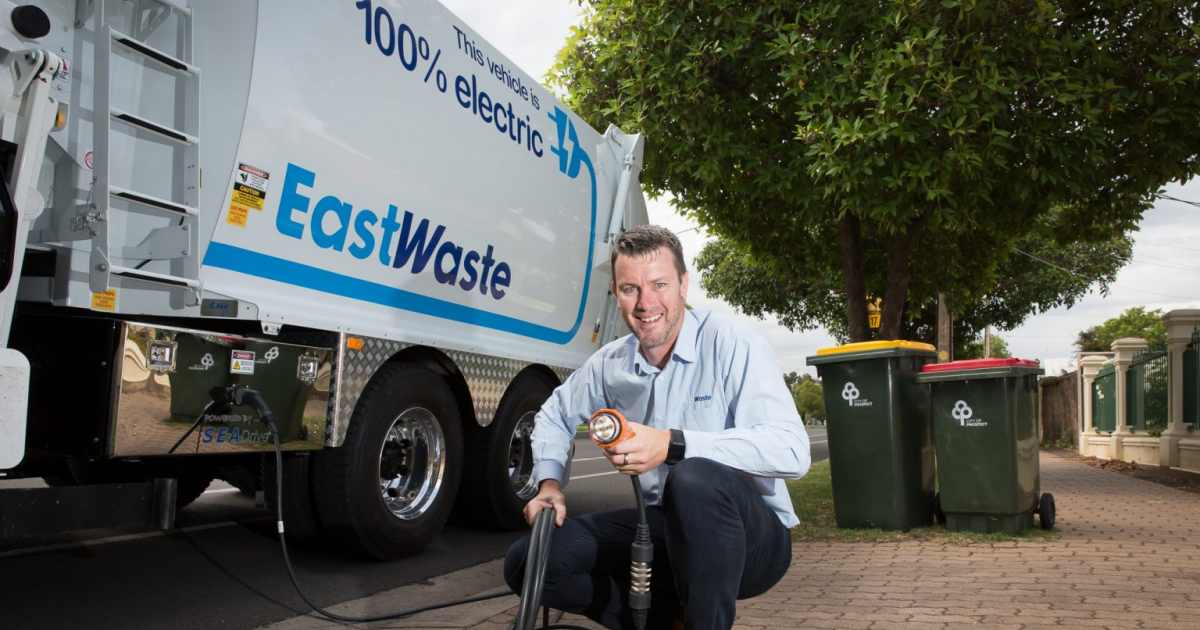
What’s said to be South Australia’s first zero-emissions electric-powered kerbside garbage and recycling collection truck went into service in Adelaide last week.
The truck was supplied by Queensland-headquartered Superior Pak and uses drivetrain technology from Victoria’s SEA Electric, which is enjoying significant success with its commercial EV solutions both locally and overseas.
Zero emissions are great, but this truck is also expected to save East Waste a chunk of change.
“It is much more than a terrific environmental initiative by East Waste,” said General Manager Rob Gregory . “It will deliver financial gain to better manage the cost of kerbside collections of recyclable resources and waste.”
Valued at approximately $550,000, the EV cost $150,000 more than a diesel truck, but East Waste has conservatively projected it will save more than $220,000 over its seven year life compared to a diesel truck – so net savings of $70,000 or $10,000 a year. This is due in part to the difference in “fuel” costs, and maintenance costs reduced by at least two-thirds. East Waste points out the savings could be higher if the cost of diesel goes up and the truck lasts more than seven years, which is expected.
What’s Charging It?
Electricity used for recharging the truck is being offset by a 36kW solar power system at East Waste’s Ottaway depot. Details weren’t provided on how much energy the truck will consume over a typical day or whether the solar panels will generate equivalent to its requirements, but the solar system should crank out somewhere in the region of 56.8 megawatt-hours of electricity annually.
Even if the solar panels don’t cover all its energy use (and my guess is they won’t, making the zero emissions claim debatable), South Australia’s electricity supply is becoming increasingly cleaner – more than half of the state’s generation is from wind and solar energy.
Emissions reduction and financial savings aside, another advantage of using electric trucks for rubbish and recycling runs is they are much quieter. This means you’ll be able to hear the emptying of the neighbour’s recycling bin full of empty stubbies more clearly.
East Waste is a subsidiary of seven metropolitan Adelaide councils: the cities of Burnside, Campbelltown, Mitcham, Norwood, Payneham & St Peters and Prospect, the Town of Walkerville and Adelaide Hills Council.
Other Electric Waste Collection Trucks In Australia
Among other electric rubbish trucks in use across the country are Cleanaway’s “EVie” vehicles and a tipper truck used for hard rubbish collection by Victoria’s Yarra City Council.
Another electric recycling truck featuring SEA electric drivetrain technology, this one for SUEZ in Western Australia, has a 230kWh battery providing more than 200 kilometre driving range before recharge – but there’s lots of stopping and starting with this sort of activity. SEA Electric says it will be capable of 1,200 bin lifts a day.

 RSS - Posts
RSS - Posts



I’ve found figures for a US rubbish truck and it looks like you were right about a 36 kilowatt solar system not being enough, Michael. A US trash truck uses around 200 liters of diesel per day of use which comes to around 1 liter per kilometer.
There are 7,700 megajoules of energy in 200 liters of diesel while a 36 kilowatt solar system in Adelaide will generate around 518 megajoules per day. I presume a garbage truck will run 5 days a week and that it would be at least twice as energy efficient, but it still falls well short. Even if it’s assume it does less kilometers in a day.
Fortunately, even running it off a lot of grid electricity is still an improvement over traditional rubbish tucks.
Any feedback on how these trucks have progressed since they’ve been out there for a number of months now? Are they parked up or actually being used?
I haven’t seen them around, but I’m sure they are being used because of their lower running costs. Both for “fuel” and lower maintenance costs. There are quiet a few places around the world starting to use them.
It’s been 1 and half years, I don’t believe these trucks are being utilised? Was it all just a big marketing pitch
I don’t recall seeing it myself, but it is one truck out of 150 and the wheels move slowly. Especially on rubbish trucks.